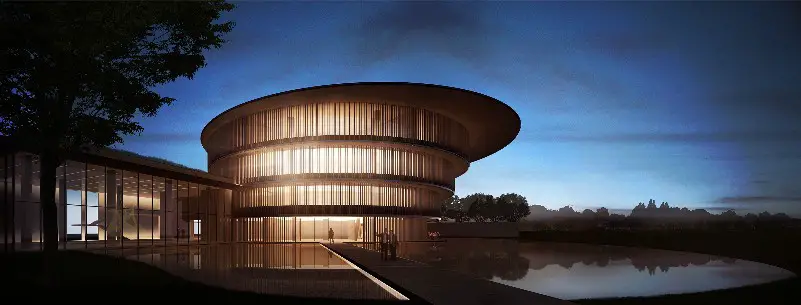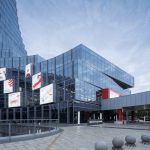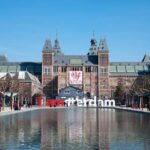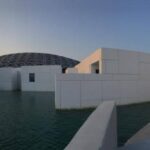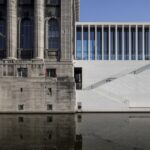He Art Museum, Shunde, Guangdong Province Culture and Art Gallery, Architecture Photos
He Art Museum in Shunde, Guangdong
Chinese Public Building Development in Southeast China design by Tadao Ando Architect & Associates
20 Jan 2020
He Art Museum in Shunde
Design: Tadao Ando Architect & Associates
Location: Shunde, Guangdong, China
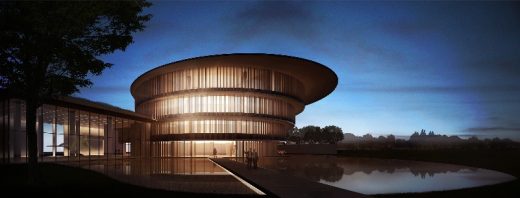
Designed by architect Tadao Ando, He Art Museum will open on 21st March 2020. © HEM
Designed by Tadao Ando Architect & Associates, He Art Museum (HEM) in Shunde will open its doors to visitors on 21st March 2020 with an inaugural exhibition curated by leading Chinese curator Feng Boyi, From The Mundane World.
HEM is conceived as a gateway into southern China’s regional Lingnan culture and arts, including Cantonese opera with theatrical face painting and intricate and distinctive Cantonese cuisine. Its remarkable collection of Lingnan School paintings showcases the indigenous style of painting originally created by artists living in the three coastal provinces of Guangdong (also known as Canton), Guangxi and Hainan, an island in the south China sea.
Tadao Ando extensively researched China’s ancient history and Lingnan’s architecture to inform HEM’s design. Ando holds a persistent attitude in cultural infusion by drawing inspiration from the local architectural and cultural context in Shunde. Named after the museum’s founder He Jianfeng, “He” in Chinese also carries multiple meanings: harmony, balance, fortune and union. Ando has drawn from these connotations and Lingnan architecture’s technique of spatial integration for HEM’s design.
Tadao Ando said: “I want to create a museum that can synthesize southern China’s rich diverse cultures that stretches many millennia and the influences that birthed Lingnan architecture. I imagined HEM as an energetic central anchor point to all the artistic and regional custom, climate, landscape and civilisation in Lingnan. I hope HEM can become the heart of Lingnan culture, not just in Shunde but the whole Greater China. I look forward to seeing the artworks and programmes activate the building, stimulating provoking thoughts with high quality spaces and art.”
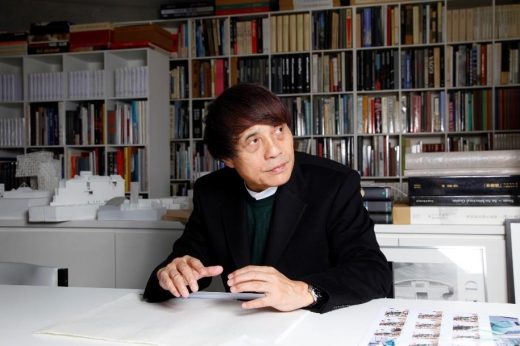
Architect Tadao Ando designed the He Art Museum © Tadao Ando Architect & Associates
Throughout history, Lingnan’s architecture has been heavily influenced by Jiangnan styles, a delta region in the immediate south of the Yangtze River and comprises scenic water towns such as Hangzhou and Shanghai. Jiangnan has a reputation of “Venice in the East” with traditional two stories buildings built next to waterways and canals, low perimeter walls and openness to scenic vistas and nature. Lingnan has a naturally similar terrain and adopts Jiangnan’s architectural characteristics such as central skywells, waterside pavilions and musing gardens to compliment the landscape.
In addition, ancient Chinese cosmology and philosophy believed the sky was round and divine; the earth was flat and square – this has had a profound influence on ancient architectural theories and design. Many civic and religious buildings were circular to reflect the idea of a “round sky”; imperial city planning, numerological and spatial arrangements were driven by these ancient Chinese cosmology and philosophies – many of these buildings are preserved even until today in the Lingnan region.
In HEM’s design, Ando draws inspiration from ancient Chinese cosmology, philosophy, western style’s use of light and Lingnan’s terrain. Throughout western architectural history, architects have been skilful at the use of light such as those seen in churches; this has had a deep impression on Ando and his approach to design.
The central skywell floods each floor of exhibition spaces with natural light, creating spaciousness, clarity and a symbol of hope. The circular form gives a nod to the traditional Chinese architectural principles and creates a modern interpretation that can reinvigorate architectural heritage from both the east and west.
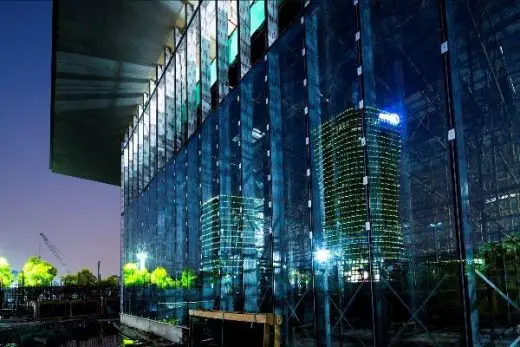
Designed by architect Tadao Ando, He Art Museum will open on 21st March 2020. © HEM
In the central skywell, a ‘double-helix’ pair of staircases takes visitors from the ground floor to the fourth floor – when two people simultaneously walk up or down the stairs, it creates a dynamic geometry of rhythm and the movement creates a kinetic human dialogue in itself. All floors of the exhibition spaces are circular except for the square gallery on the ground floor, which also accommodates an open plan bookstore and a café. Additionally, a 300-square-meter flexible education space can double up as a place for quiet studying, socialising or events.
A pond is wrapped around the building which mimics Lingnan’s heritage of waterside pavilions and as a symbol that subtly gestures its geographic location on the Pearl River estuary. Visitors can access the museum via a pathway, creating a journey of mindfulness, tranquillity and a moment for contemplation.
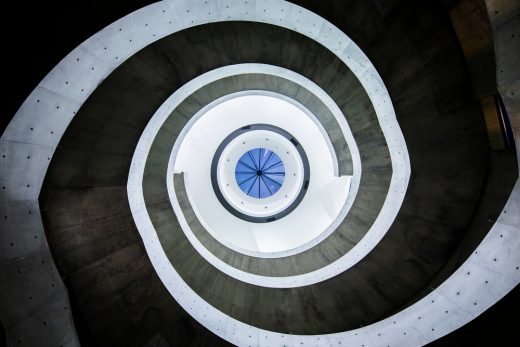
Partial View of He Art Museum © HEM
The first exhibition in the rotating programme, From the Mundane World, examines the ecology between humans and their environment, patterns of civilisation and mass consumption, and reflects on the fast-paced urban transformation that China and its people are experiencing. In addition, other temporary exhibitions will display archives of rare Lingnan art, offering visitors a glimpse into indigenous Lingnan culture. Major works by international contemporary masters such as Pablo Picasso, Damien Hirst and Yayoi Kusama will also be showcased; as well as promoting Chinese modern art with works by Qi Baishi, Chang Dai-Chien and many more.
Lingnan region encompass an expanse of 39 cities, two autonomous regions of Hong Kong and Macau and border Vietnam. The English translation of Lingnan means ‘South of the Ranges’, referring to the region south of the five mountain ranges that separate the Yangtze River from the Pearl River. HEM is served by Guangzhou South High-Speed Rail station and within proximity to four international airports, trainlines are directly connected to Hong Kong via key cities in the region.
About HEM
Located in Shunde, Guangdong province in southern China and home to its founder He Jianfeng, HE Art Museum HEM is set to become a new leading private art museum. Home to He family’s extensive art collection, it comprises over 400 art works and commissions by renowned international and Chinese artists. As an international gateway into the Lingnan School and Cantonese culture heritage, HEM is committed to becoming the conduit for academic exchange through its ground-breaking architectural design, exhibitions and public amenities. HEM aims to become a forum leading the conversations in social mobility and cultural initiatives in Greater Bay Area in China.
About Tadao Ando
Born 1941 in Osaka, Japan. Self-taught in architecture. Established Tadao Ando Architect & Associates in 1969. Major works include the Church of the Light, Pulitzer Arts Foundation, and Chichu Art Museum. Awarded the Architectural Institute of Japan (AIJ) Prize for the Row House in Sumiyoshi in 1979, Japan Art Academy Prize in 1993, Pritzker Architecture Prize in 1995, Person of Cultural Merit (Japan) in 2003, International Union of Architects (UIA) Gold Medal in 2005, John F. Kennedy Center Gold Medal in the Arts in 2010, Shimpei Goto Award in 2010, Order of Culture (Japan) in 2010, Commander of the Order of Art and Letters (France) in 2013, Grand Officer of the Order of Merit (Italy) in 2015, and Isamu Noguchi Award in 2016. Held solo exhibitions at the Museum of Modern Art (MoMA) in 1991 and Centre Pompidou in 1993. Taught as a visiting professor at Yale University, Columbia University, and Harvard University. Professor at the University of Tokyo from 1997. Professor emeritus of the University of Tokyo since 2003.
About Shao Shu
Graduated from Shanghai Theatre Academy, majoring in Arts Management, Shao has been a curator in China for more than a decade. He was appointed as the Director of He Art Museum in 2017 and oversees the museum’s operation and overall curatorial vision. Prior to this, he was with Long Museum from 2012 to 2017.
Shunde, Guangdong, China
Shunde is one of the five districts in Foshan city in Guangdong province, part of a megalopolis consisting of 9 cities and 2 special administrative regions known as Greater Bay Area (GBA) in southern China. GBA comprises the two Special Administrative Regions of Hong Kong and Macao, and the nine municipalities of Guangzhou, Shenzhen, Zhuhai, Foshan, Huizhou, Dongguan, Zhongshan, Jiangmen and Zhaoqing in Guangdong Province. With a population of 70 million, transport links to four international airports and a direct rail link to Beijing, Shanghai, Hong Kong and other major cities in China.
He Art Museum in Guangdong – Building Information
Finishing design: Matrix Design
Museum Opening Hours: Tuesday-Sunday 10:00-18:00 (Closed on Mondays)
Ticket price: General admission | RMB 150 Kids & Teens (18 & under), Student (18+ with ID), Senior (65+) | RMB 60 Free admission on the 20th of every month
Photography: © HEM and © Tadao Ando Architect & Associates
Tadao Ando Architects, Japan
He Art Museum in Shunde, Guangdong images / information received 200120
Location: Shunde, Guangdong, China
China Architecture
– chronological list
Chinese Architect – Design Practice Listings
Architect: The Architectural Design & Research Institute Of ZheJiang University Co,Ltd
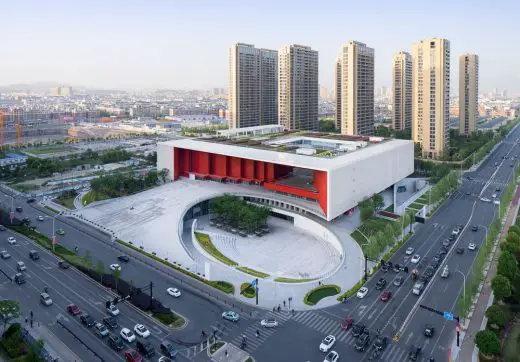
photograph : Qiang Zhao
Yiwu Cultural SquareBuilding
Design: The Architectural Design & Research Institute Of ZheJiang University Co,Ltd
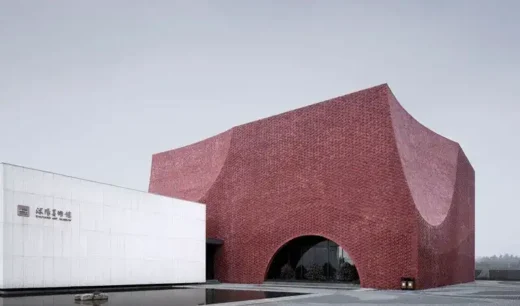
photograph : Qiang Zhao
Shuyang Art Gallery Building
Comments / photos for the He Art Museum in Shunde, Guangdong page welcome

